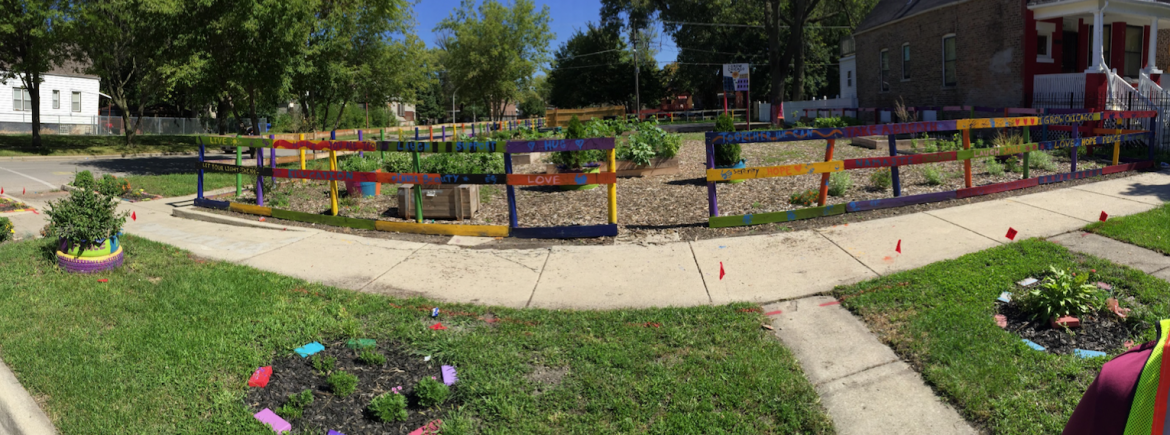
A formerly vacant Chicago lot is now an urban garden. Image: William Stewart
By Ian Wendrow
Chicago is selling online scores of abandoned city property in the Greater Englewood and East Garfield neighborhoods.
Residents of these two southwest communities can buy vacant lots in their neighborhoods for just $1. Through a website bearing the program’s name, LargeLots.org, residents apply for the lots to increase their own property value and improve their neighborhoods.
Large Lots began as part of Chicago Mayor Rahm Emanuel’s five-year housing plan. That program provides a roadmap for the purchase, restoration and upkeep of housing with another program called Green Healthy Neighborhoods.
Green Healthy Neighborhoods was implemented in 2014 within the Greater Englewood area to promote eco-friendly urban restoration. Large Lots streamlines application, purchase and closing of lot sales, says Peter Strazzabosco, the deputy commissioner for Chicago’s Department of Planning and Development.
“It’s been a very successful program,” Strazzabosco said. “People are fairly enthusiastic about purchasing long-vacant, city owned blocks for their own personal or community uses.”
Residents can do whatever they wish with their lots so long as it complies with zoning. Lots have been used by participants to create gardens, public gathering places, playgrounds for children and recreation areas for young adults.
Most participants take up environmental stewardship with their new lots, said Paul Gobster, a research landscape architect with the U.S. Forest Service’s Northern Research Station.
Roughly 90 percent of the purchased lots have gone a “green route,” Gobster said, meaning the lots have been used for gardening purposes or other environmentally conscious uses. His research team began working with Large Lots in the spring of 2015, documenting the program’s environmental impact.
“I didn’t really have any expectations one way or another but we were surprised how fast it had taken,” Gobster said.
“I guess I would say things look to be going well.”
While Gobster and the U.S. Forestry Service assesses the environmental component of the program, William Stewart, a professor within the Department of Landscape Architecture at the University of Illinois, looks at how residents respond to the changes brought on by Large Lots.
Using three focus groups of 25 to 30 participants, Stewart found that environmental stewardship ranks high in terms of how residents feel about their part in the Large Lots program.
“We had 80 percent agree with the statement ‘I am obligated to protect the environment in my neighborhood,” Stewart said.
Similar questions ranked high as well, with most participants agreeing with sentiments of moral and ethical obligations to protect and promote the environment within their own neighborhoods.
Other motives are also at play.
Stewart found that a prominent theme among those engaged with Large Lots was a desire to invest money into their neighborhoods. By livening up the physical appearance of these blocks, Stewart argues, residents are hopeful that more investment and house purchases will come to these economically challenged areas. And that can raise the value of their own property.
Although residents believe new people are important for the health of their neighborhoods, they also recognize the importance of rebuilding a connection among current property owners.
“Historically there is this concept called ‘block clubs’ in Chicago where each sort of block or two would have their own club and be like a social group,” he said. “There’s many people who remember the block clubs and have brought that back.”
Environmental stewardship has played a major role in reviving these clubs, Stewart said, by incentivizing residents to contribute towards the care of their neighborhoods and giving younger residents a safe, productive area to learn about their communities.
Gobster and his team plan to collect data over the next five years to build a comprehensive report on Large Lots’ impact. Strazzabosco and his department intend to conduct more research of their own as well.
Gobster sees the implications of this project going further than just the Midwest.
“There’s people concerned about urban vacancy in Japan and Eastern Europe, so vacancy is not just a Great Lakes or Rust Belt phenomenon. It’s happening nationwide and internationally,” he said.
The factors bringing about urban decay in other parts of the world are different than Chicago’s. But the problems facing these cities are the same, he said, and need to be tackled by asking an important question:
“How do you revitalize by getting people to do things differently?”
